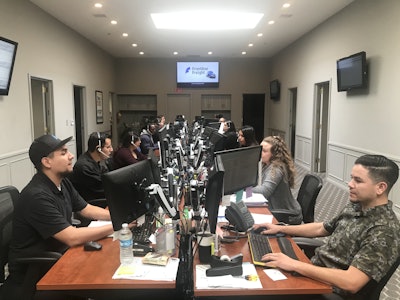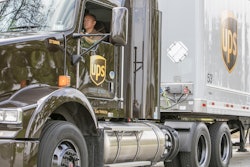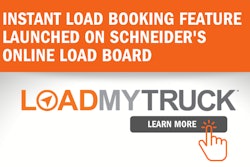 In response to a survey, motor carriers said the technology options a shipper or 3PL offers is a top consideration for doing business.
In response to a survey, motor carriers said the technology options a shipper or 3PL offers is a top consideration for doing business.The expectations of shippers, 3PLs, and carriers have traditionally moved down a one-way street. Shippers passed expectations for pricing, service, and other facets of relationships to 3PLs and carriers vying for their business.
Results from a survey in late 2018 by the Transportation Intermediaries Association (TIA) show that directional changes were made, resulting from an industry-wide driver shortage and compliance with the electronic logging device (ELDs) rule. Increasingly, these factors changed the dialogue for all parties to meet driver expectations and make the most of the 660 minutes of driving availability each day.
With a downturn in the freight economy in 2019, the pendulum moved back in the direction of shippers. Even so, some changes that came out of 2018 appear to be cemented, thanks to the ELD mandate.
“The customer today is buying drivers’ hours,” says Jim Ward, president and chief executive of D.M. Bowman, a full-service trucking and logistics provider based in Williamsport, MD. “We need to work with customers to best utilize time for the driving associate.”
What matters to shippers?
To assess the expectations of shippers the TIA survey asked, “what is most important to you when looking for a 3PL or carrier?” The top choice identified by shippers was relationships (50 percent) followed by service (25 percent) and pricing (12.5 percent).
Interviews with supply chain professionals reiterated the importance of trust, communication and loyalty by saying the factors are what make it possible to solve challenges that technology cannot.
“You still need the human interface,” says J.J. Jones, chief supply chain officer of Monin Americas, a manufacturer of food and beverage flavorings with headquarters in Clearwater, FL. “You need to talk to get things done.”
 The ELD mandate caused motor carriers and drivers to raise their expectations with shippers and 3PLs to better use their resources.
The ELD mandate caused motor carriers and drivers to raise their expectations with shippers and 3PLs to better use their resources.As a shipper, Jones says to be fair to 3PLs and carriers he will honor rate increases should market dynamics change during the contract. On the other hand, Jones wishes transportation companies would return the favor if their margins increase. As an example, a 3PL may submit an RFP that has inflated rates to go into markets like Florida with more inbound than outbound freight.
“What happens when they pick up a (backhaul) load?” he asks. “Do they go back to the original customer and give a rebate? That is a friction point to me.”
What matters to carriers?
As noted previously, labor shortages and compliance with the ELD rule makes drivers’ time more valuable than ever, and further regulations, like the CDL Drug and Alcohol Clearinghouse which goes live on Jan. 6, 2020, may further exacerbate the problem. The clearinghouse will show motor carriers any CDL drivers that have previously failed federal drug and alcohol testing.
With no end in sight to the driver shortage, carriers and drivers have raised their expectations with shippers and 3PLs to better use their resources. The survey asked carriers, “what kind of business relationship do you expect from a shipper or 3PL?” Out of 10 options, the top choice by carriers (80 percent) was fair and reasonable detention time and pay after two hours.
Heatcraft Refrigeration Products, a shipper, has an agreement with its 3PL partner to receive notification 30 minutes in advance of a shipment incurring detention charges. With this advance notice, “we work with our customers or plants to find out what the holdup is,” says Alicia Whiteside, transportation analyst for the Stone Mountain, GA-based company.
When the problem cannot be resolved in a timely manner, Heatcraft pays detention according to terms of the contract. “We always try to be fair to (the 3PL) as well as drivers,” she says.
When presented with accessorial charges, J.J. Jones of Monin Americas agrees that “if something costs more to do, they need to charge.” On the other hand, he wants accessorial charges to be the actual cost, not an arbitrary rate.
As an example, a 3PL may charge $200 for adding a stop to a route. “Does it really cost that?” he asks. Another example is “truck order not used.” If a load has to be cancelled and it costs the trucker money, “we are going to pay, but what happens if the trucker was put on another load?” he asks. “Why am I still getting charged that?”
“I don’t want anything for free,” he continues. “But let’s make sure it is a real charge.”
Bringing in data
Carriers interviewed for the report by TIA said that ELDs and tracking technologies have improved turnaround times at shipper facilities by capturing data to support detention claims.
 John Elliott, CEO of Load One, says his company has had to walk away from some customers that cause driver detention.
John Elliott, CEO of Load One, says his company has had to walk away from some customers that cause driver detention.“We try to have honest conversations with shippers, and we’ve had to walk away from some if they abuse the trucks or cause detention,” says John Elliott, chief executive of Load One, an expedite carrier based in Taylor, Mich.
Alerting shippers and 3PLs to detention events with real-time communication tools helps motor carrier D.M. Bowman resolve disputes and keep drivers moving.
“The amount of good quality data available to share really helps,” says Jim Ward. “When dealing with real-time data, it really takes emotion out of the conversations and leads to a reasonable outcome.”
Some accessorial charges are difficult to include in contracts such as trailers damaged at shipping and receiving locations. Shippers and 3PLs that do not pay for equipment damages leave carriers with no other option than to build added costs into their rates, says Phil Wilt, president and chief operating officer of American Central Transport, a dry-van carrier based in Kansas City, MO.
“It’s difficult, but you have to outmaneuver them,” he says.
When facilitating transactions between shippers and carriers, 3PLs feel pressure from both sides to resolve accessorial charges. When transactions fail to meet the expectations of a carrier, “we take our lumps sometimes,” says Brandon Arnold, vice president of Intelligent Logistics based in Austin, Texas.
Intelligent Logistics moves between 8,000 and 10,000 loads a year, mostly long-haul shipments with specialized, time-sensitive requirements.
“If a customer is not compensating us for the work a carrier did, we are not going to penalize the carrier,” he says. “If (the customer) is not being reasonable, we have to make a decision if they are the right fit for us.”
Vetting shippers and 3PLs
The survey asked carriers, “what kind of processes do you have for vetting a shipper or 3PL?” The top choice (57.35 percent) was check references followed by ensure compliance with FMCSA (38.24 percent). The breakdown of other choices are as follows:
- Technology options available (37 percent)
- If 3PL, who their bond/trust company is with (31 percent)
- Base opinion on word of mouth (31 percent)
- If 3PL, see that they are a TIA member (25 percent)
When evaluating customers, Jim Ward of D.M. Bowman says throughput at facilities, such as their use of dropped trailers versus live loads, is critical to “protect the integrity of our professional driver hours.”
 Phil Wilt, president of American Central Transport, says the company goes through a questionnaire with prospective customers to clearly understand their expectations and freight needs before committing.
Phil Wilt, president of American Central Transport, says the company goes through a questionnaire with prospective customers to clearly understand their expectations and freight needs before committing.“In today’s environment, you need to get volume and utility out of equipment,” he says. Having safe and maneuverable parking locations that drivers can use while waiting for dock access, driver restrooms and amenities are other key factors for vetting.
“We’ve been pretty disciplined in taking business after knowing what kinds of challenges we are confronted with,” he says. “We vet new business the best we can. We get surprised on occasion, but there has to be a curing period when we take in good data.”
Phil Wilt says American Central Transport goes through a questionnaire with prospective customers to clearly understand their expectations and freight needs before committing. Shipment density and frequency are critical factors.
John Elliott of Load One agrees that discussing expectations is the most important part of the vetting process to “make sure you understand upfront if you can meet them or if you will not be a good fit,” he says. Payment terms, throughput at facilities, shipment frequency and other factors are considered as well.
If the relationship is not sustainable, it’s better to be honest about it and avoid service issues that may hinder opportunities to work together in the future, he recommends.
“Sales guys want to sell everything,” he says, but “setting expectations is big for both sides.”
Success metrics for relationships
Several metrics can be used to gauge the success of relationships between shippers, 3PLs and carriers. As previously mentioned, shippers have traditionally dictated the scorecard metrics for relationships based on price, on-time service, load acceptance rates and other factors.
Scorecards kept by 3PLs and carriers are carrying more weight. D.M. Bowman, for instance, has created a scorecard that it shares with customers to compare assumptions the carrier had when bidding the freight to realities on the ground.
Some of the most important metrics, Ward says, are the operating hours of facilities and the speed of loading and unloading. The carrier also has a Rate My Load app that drivers use to provide feedback on shipper facilities and other experiences. The feedback goes straight to Ward, the CEO, and to the company’s chief operating officer.
“We want to make sure that if shippers are doing a great job, they know it. And if we have a location that is a challenge for us, we engage them,” he says.
With more carriers going to hourly and guaranteed pay programs for drivers, working with customers that provide shipment density, consistency and efficiency for their freight networks has become more important, says ACT’s Phil Wilt.
“If we are not moving,” he says, “we may have to fire you as a customer. Five years ago, we never would have done that. We would do whatever you need, even if you abuse us.”
Coming to terms with technology
The study shows technology is a common denominator of successful relationships. Electronic data interchange (EDI), web portals, TMS systems and other connectivity tools help all parties establish trust, open communications and deliver on expectations.
Heatcraft Refrigerated Products is connected to the TMS of its 3PL partner to track the location and status of loads, to streamline communications, retrieve proof-of-delivery receipts and pull reports.
“The TMS is definitely important for those reasons,” she says. “Trust is very big in our business.”
For motor carrier ACT, its customers that use EDI are generally the easiest to do business with, Wilt says. More important than receiving loads via EDI is if the loads “are really there,” he continues. A customer may give a load a month in advance, but the load may not be available when the time comes. Wilt prefers getting “real” loads three to five days ahead of time to optimize the planning process.
Motor carriers say technology has enabled them to capture and present data to shippers and 3PLs to facilitate discussions on how best to improve asset utilization and the driver experience.
“We have seen shipper facilities become more driver friendly,” says Jim Ward with D.M. Bowman. “We have seen individuals become interested in getting a better understanding of the utility of assets and the velocity of business.”
Building on common ground
Flexibility surfaces during interviews with 3PLs and carriers as a key factor in business relationships to maximize driver productivity. Several companies mentioned the need to work with shippers as well as with carriers that have flexible operating hours to avoid costly disruptions.
Motor carrier Load One, for instance, has true 24/7 operations. When a customer calls at odd hours, “some guy is not getting a phone call at home,” says John Elliott. He also values doing business with customers that have flexible operating hours at loading and unloading facilities.
If a load is behind schedule, some shippers will move the driver to the end of the line, which often means having to wait to deliver the following day.
“Some shippers are very stringent with delivery times and loading and unloading,” Elliott says. “We understand, but it’s not a good policy. If you are two hours late loading us, we don’t say ‘Sorry, we’ll be there three days later.’ If a customer can work with you, that is really helpful.”
For Intelligent Logistics, the availability of carriers is a critical factor of successful relationships. “We need a lot more than 8 to 5 business hours,” he says. “We aren’t the post office.” He also wants carriers to have tracking technology and evaluates their process for post-delivery communication. Additionally, Arnold says he wants to do business with carriers who are not “one-and-done,” since “we want to be a long-term partner.”
Relationships still matter
In researching the perspectives of shippers, 3PLs, and carriers the final analysis shows that technology is not about to replace the human factor of relationships to understand and deliver on expectations.
“Everybody wants something different,” Elliott says. Some customers have unique paperwork and load handling requirements, for example. “It’s very hard to teach those requirements.”
For this reason and others, Load One has organized its customer service department into eight teams, and assigned each team a group of customers.
“It’s still about the relationship,” Elliott says. “If you break into teams it gives you the relationship factor. If service and price are equal, the relationship is the swing vote.”
In 2019 and beyond, successful relationships will continue to revolve around maximizing driver utilization, Ward expects.
“Today, more than ever, we have adopted the philosophy that when doing business ‘if it’s good for the driver it is good for us,’” he says.












